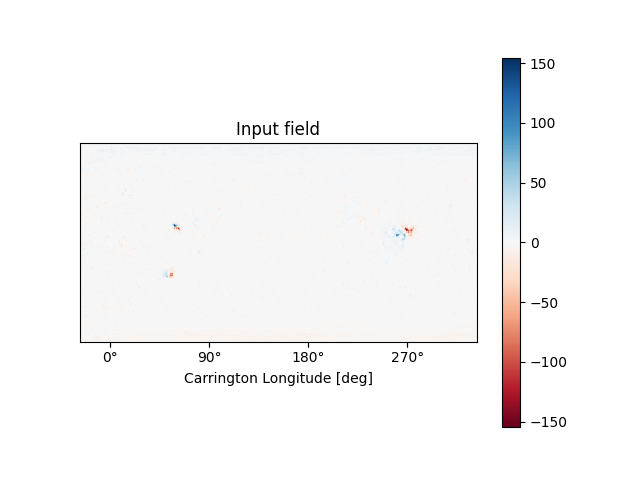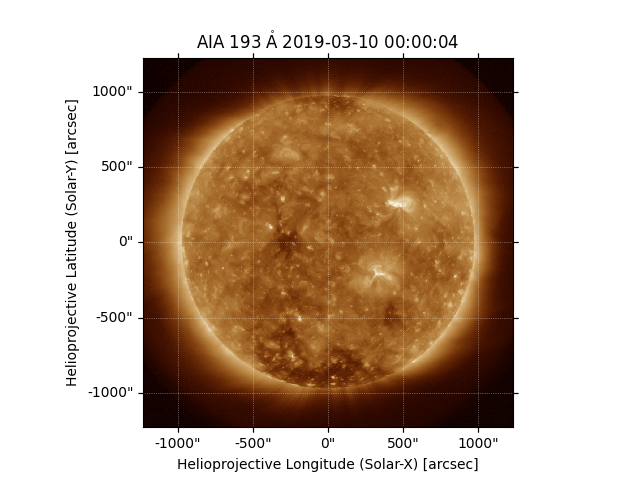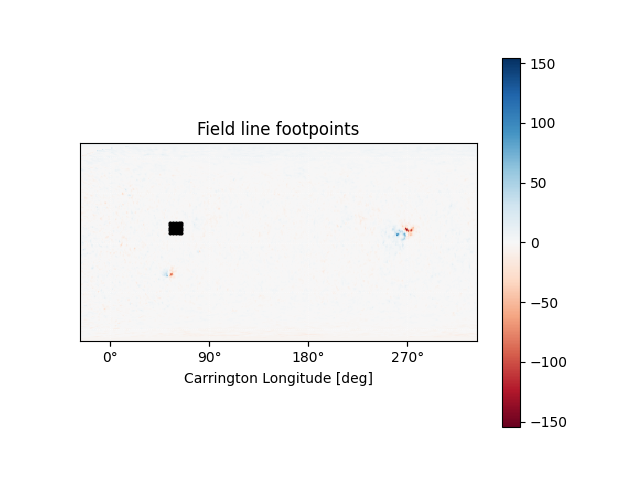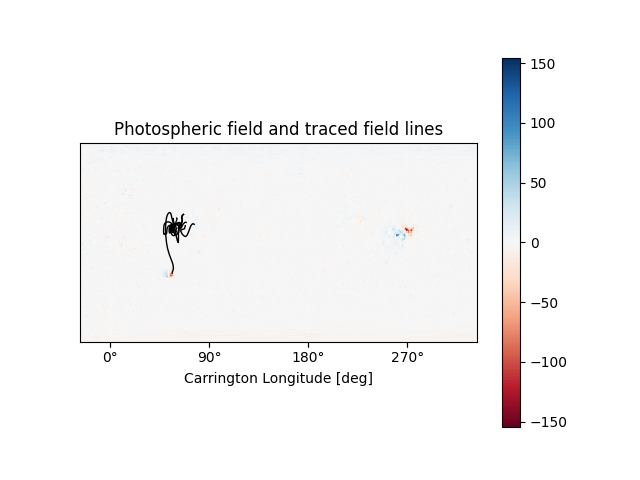Note
Click here to download the full example code
Overplotting field lines on AIA maps¶
This example shows how to take a PFSS solution, trace some field lines, and overplot the traced field lines on an AIA 193 map.
First, we import the required modules
from datetime import datetime
import os
import astropy.constants as const
import astropy.units as u
from astropy.coordinates import SkyCoord
import matplotlib.pyplot as plt
import numpy as np
import sunpy.map
import sunpy.io.fits
import pfsspy
import pfsspy.coords as coords
import pfsspy.tracing as tracing
from gong_helpers import get_gong_map
Load a GONG magnetic field map. If ‘gong.fits’ is present in the current directory, just use that, otherwise download a sample GONG map.
gong_fname = get_gong_map()
We can now use SunPy to load the GONG fits file, and extract the magnetic field data.
The mean is subtracted to enforce div(B) = 0 on the solar surface: n.b. it is not obvious this is the correct way to do this, so use the following lines at your own risk!
gong_map = sunpy.map.Map(gong_fname)
# Remove the mean
gong_map = sunpy.map.Map(gong_map.data - np.mean(gong_map.data), gong_map.meta)
Load the corresponding AIA 193 map
if not os.path.exists('AIA20190310.fits'):
import urllib.request
urllib.request.urlretrieve(
'http://jsoc2.stanford.edu/data/aia/synoptic/2019/03/10/H0000/AIA20190310_0000_0193.fits',
'AIA20190310.fits')
aia = sunpy.map.Map('AIA20190310.fits')
dtime = aia.date
The PFSS solution is calculated on a regular 3D grid in (phi, s, rho), where rho = ln(r), and r is the standard spherical radial coordinate. We need to define the number of grid points in rho, and the source surface radius.
nrho = 25
rss = 2.5
From the boundary condition, number of radial grid points, and source
surface, we now construct an Input object that stores this information
input = pfsspy.Input(gong_map, nrho, rss)
Using the Input object, plot the input photospheric magnetic field
m = input.map
fig = plt.figure()
ax = plt.subplot(projection=m)
m.plot()
plt.colorbar()
ax.set_title('Input field')

Out:
Text(0.5, 1.0, 'Input field')
We can also plot the AIA map to give an idea of the global picture. There is a nice active region in the top right of the AIA plot, that can also be seen in the top left of the photospheric field plot above.
ax = plt.subplot(1, 1, 1, projection=aia)
aia.plot(ax)

Out:
<matplotlib.image.AxesImage object at 0x7f98d31d2710>
Now we construct a 10 x 10 grid of footpoitns to trace some magnetic field lines from.
s, phi = np.meshgrid(np.linspace(0.1, 0.2, 5),
np.deg2rad(np.linspace(55, 65, 5)))
lat = np.arcsin(s) * u.rad
lon = phi * u.rad
seeds = SkyCoord(lon.ravel(), lat.ravel(), 1.01 * const.R_sun,
frame=gong_map.coordinate_frame)
Plot the magnetogram and the seed footpoints The footpoints are centered around the active region metnioned above.
m = input.map
fig = plt.figure()
ax = plt.subplot(projection=m)
m.plot()
plt.colorbar()
ax.plot_coord(seeds, color='black', marker='o', linewidth=0, markersize=2)
ax.set_title('Field line footpoints')
ax.set_ylim(bottom=0)

Out:
(0.0, 179.5)
Compute the PFSS solution from the GONG magnetic field input
output = pfsspy.pfss(input)
Trace field lines from the footpoints defined above.
tracer = tracing.PythonTracer()
flines = tracer.trace(seeds, output)
Plot the input GONG magnetic field map, along with the traced mangetic field lines.
m = input.map
fig = plt.figure()
ax = plt.subplot(projection=m)
m.plot()
plt.colorbar()
for fline in flines:
ax.plot_coord(fline.coords, color='black', linewidth=1)
# ax.set_xlim(55, 65)
# ax.set_ylim(0.1, 0.25)
ax.set_title('Photospheric field and traced field lines')

Out:
Text(0.5, 1.0, 'Photospheric field and traced field lines')
Plot the AIA map, along with the traced magnetic field lines. Inside the loop the field lines are converted to the AIA observer coordinate frame, and then plotted on top of the map.
fig = plt.figure()
ax = plt.subplot(1, 1, 1, projection=aia)
transform = ax.get_transform('world')
aia.plot(ax)
for fline in flines:
ax.plot_coord(fline.coords, alpha=0.8, linewidth=1, color='black')
ax.set_xlim(500, 900)
ax.set_ylim(400, 800)
plt.show()
# sphinx_gallery_thumbnail_number = 5

Total running time of the script: ( 0 minutes 16.790 seconds)